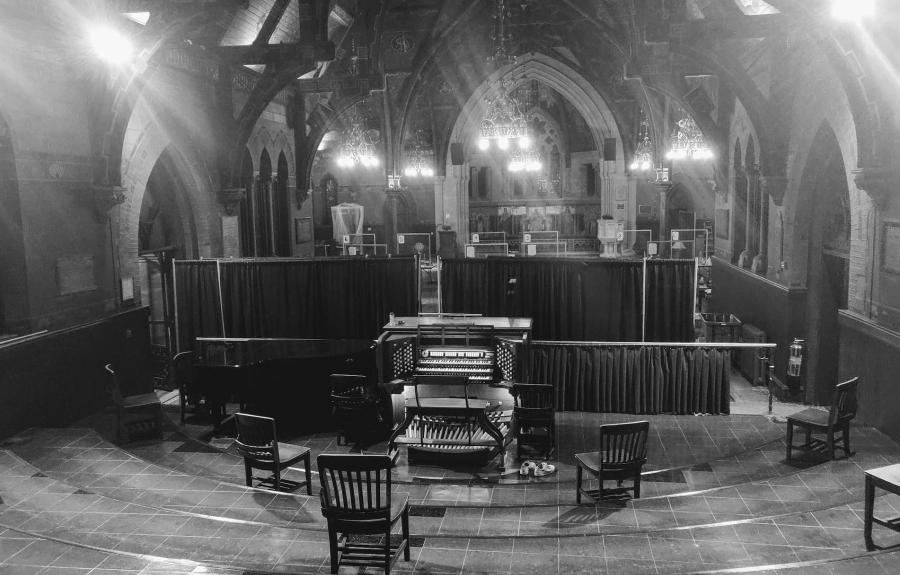Overview
The golden pipes of the Sage Chapel organ frame a stunning rose window: the image is surely a Cornell icon, familiar to class after class of Cornellians since the Aeolian-Skinner first sounded in this space over eighty years ago. 1940 saw both the building of this organ and the celebration of the seventy-fifth anniversary of Cornell’s founding charter. This is the third organ to grace Sage Chapel since it opened in 1875, one of the oldest buildings on Cornell’s campus. The chapel was always intended as a center for ecumenical theological debate, as Cornell’s first president, Andrew Dickson White, was keen to establish the “Sage Lectureship in Christian Ethics” and bring the best thinkers from across the country to speak to the students; Dean Sage ensured the endowment fund would bring the best ministers from different denominations to the pulpit. Over the years the chapel has rung to the sound of many famous voices, including Martin Luther King, Elie Wiesel, and Paul Tillich, and it remains a quiet oasis at the heart of Cornell’s campus. The Apostles Rose Window, framed now by the Aeolian-Skinner’s golden façade, has looked out over the chapel since its very first days, preserved and moved to its current location above the organ in 1940.
A. D. White intended to provide “music of the best and noblest kind” for the new chapel. He personally supervised the plans for the chapel’s first organ, built by Hook and Hastings of Boston: a modest instrument of two manual and pedals, of which nothing survives. In 1898, concurrent with alterations to the chapel that substantially enlarged the space, the first organ was rebuilt by King & Son of Elmira; this substantial rebuild added a third manual, and ushered in electric key and stop action. The golden façade today still incorporates part of the Pedal Violone 16’ from the 1898 King organ. A decade later, after the chapel was expanded yet again, an entirely new organ was commissioned from the E. M. Skinner Company in Boston. With four divisions and pedal, and electro-pneumatic action, this organ was inaugurated in January 1910, and sat in the chapel wing to the left of the altar. It was standing room only at times for the ever-popular organ recitals in Sage. Reporting on one such concert, the Alumni News wrote in March 1910, “to provide good music in a beautiful place like Sage Chapel for all who may come, is to do something that is quite within the province of the true university.”
The current organ was built for Sage Chapel in 1940, under the direction of G. Donald Harrison for the Aeolian-Skinner Company of Boston. Overlooking the choir loft of the newly extended west end of the chapel, at fifty-eight stops, and over 4,000 pipes, it was at the cutting edge of Harrison’s design, incorporating neo-Baroque elements and French-style reeds as well as several ranks re-used from the earlier instruments. In particular, the Choir division incorporated stops from the 1909 E. M. Skinner organ (only the Zauberflöte 2’ and Cromorne 8’ were new), including the characteristic Erzähler and Celeste, a stop invented by E. M. Skinner in 1904; these older colors sit now alongside a Baroque-inspired “Positiv” division. The beautiful Swell Oboe is also a legacy of the Skinner organ. The Sage Organ represents a step towards Harrison’s desire to build a new style of organ to suit the American context: as he wrote in 1944, America’s artistic culture “is at present in the making!” Over the following decades, the organ has become a fixture of Cornell’s musical life, supporting university services, accompanying a full chapel at the December Lessons and Carols, providing support for concerts of the Glee Club, Chorus, and Chorale––and its console has hosted countless visiting recitalists and home-grown talent. It even kept silent watch over the chapel during its time as a makeshift testing site in the earlier days of the COVID-19 pandemic. In 2022, the organ rang out with full voice once more, after two years of painstaking work by Parsons Pipe Organ Builders to clean the entire instrument, releather the wind chests, and restore the reeds.
Specification
| Great | Swell | Choir | Positiv | Pedal |
|---|---|---|---|---|
| Principal 8’ | Bourdon 16’ | Viole 8’ | Gedeckt 8’ | Contra Bourdon 32’ |
| Bourdon 8’ | Diapason 8’ | Concert Flute 8’ | Nachthorn 4’ | Principal 16’ |
| Spitzflöte 8’ | Stopped Diapason 8’ | Erzähler 8’ | Nasat 2 2/3’ | Violone 16’ |
| Principal 4’ | Viole de Gambe 8’ | Erzähler Celeste 8’ (from tenor C) | Italian Principal 2’ | Bourdon 16’ |
| Rohrflöte 4’ | Viole Celeste 8’ | Flauto Traverso 4’ | Terz 1 3/5’ | Echo Lieblich 16’ (from Swell) |
| Quint 2 2/3’ | Sesquialtera II | Zauberflöte 2’ | Oktav 1’ | Principal 8’ |
| Super Octave 2’ | Principal 4’ | English Horn 8’ | Zimbel III | Gedackt Pommer 8’ |
| Full Mixture IV | Cor de Nuit 4’ | Cromorne 8’ | Violone 8’ | |
| Fourniture IV | Fifteenth 2’ | Tremolo | Quint 5 1/3’ | |
| Cymbel III | Plein Jeu III | Principal 4’ | ||
| Trumpet 8’ | Fagotto 16’ | Koppelflöte 4’ | ||
| Trompette 8’ | Blockflöte 2’ | |||
| Vox Humana 8’ | Fourniture IV | |||
| Oboe 8’ | Bombarde 16’ | |||
| Clarion 4’ | Tompette 8’ | |||
| Tremolo | Clarion 4’ |


